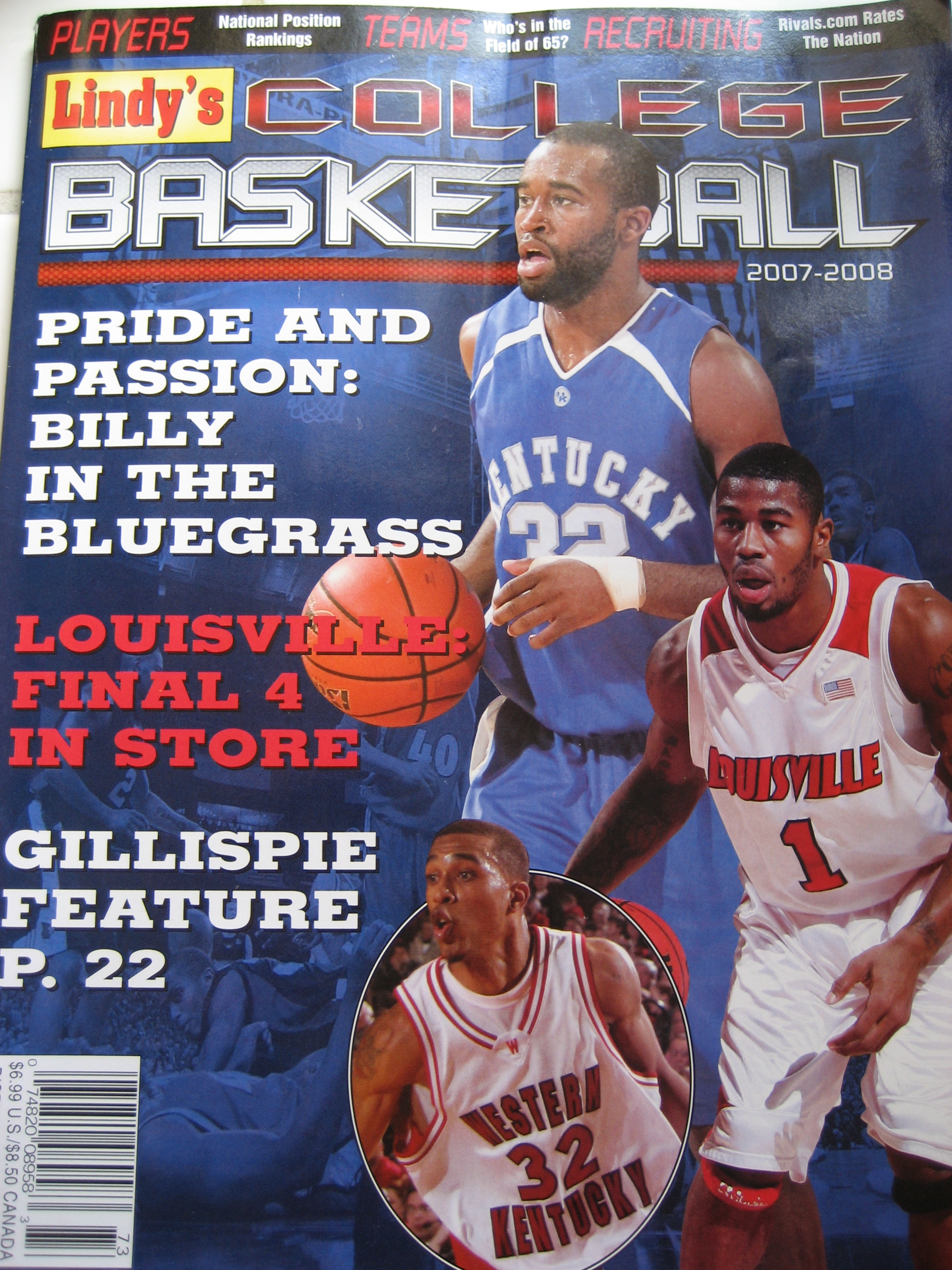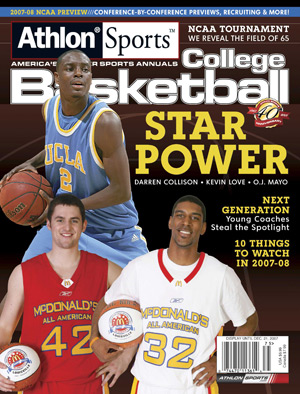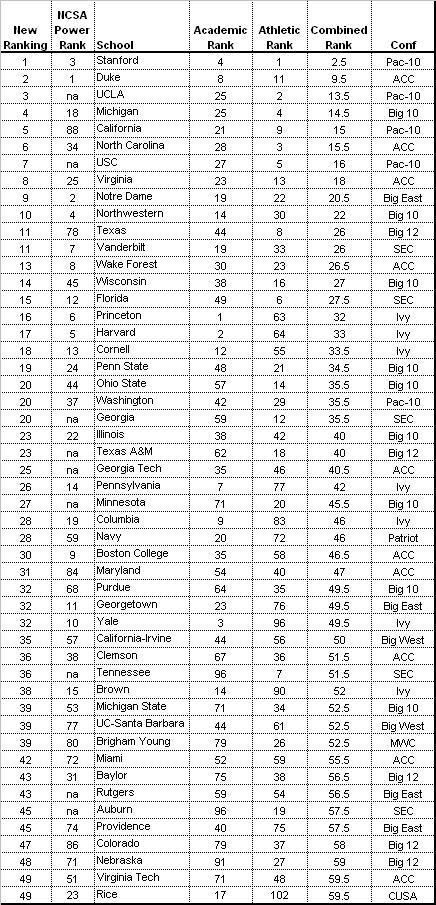Breaking Down the Preseason Mags… pt. 2
Posted by rtmsf on September 14th, 2007So Wednesday we established that the Athlon Sports preseason magazine is one that you probably shouldn’t take home with you. Unless you’re the type of person who goes gaga over seeing your favorite team/player on the cover and must own them all in a Sisyphian quest to document every newsworthy event involving it throughout history. Consider this excitable Carolina fan’s tale we stumbled across today (re: the Athlon issue)…
So I will do what I do every year – wait until all the mags are out, then drive up to visit my brother in NC and buy every mag with a Heel on the cover. That is always one of my most happy trips of the year.
Hey, we don’t judge. So here’s the second installment of our continuing series of reviews of the preseason magazines.
Next Up: Lindy’s.

I. Covers (5 pts) – are they cool? inclusive?
- 21 regional covers is a nice number, but the Rocky Mtn states aren’t represented in the least – Does Lindy’s realize that the Mountain West and WAC have fans too?
- Coolest Cover – none – they’re pretty much all the same format, with multiple players photographically stacked on top of each other.
- Say What? The Tennessee issue highlights UT, Memphis, Vandy and the Lady Vols?? The NE issue features UConn, BC and something called the “Lady Huskers,” which we assume is supposed to be “Huskies.” Either way, we have no tolerance for this.
- Total Points = 2
II. Ease of Use (5 pts) – how hard is it to find confs/teams?
- Somewhat difficult upon first glance. Eleven major conferences are arranged alphabetically, then by predicted order of finish of its teams. The rest of the conferences are shoved into the back of the mag with the teams arranged alphabetically within. Confusing.
- Standard format otherwise – roundup, features & predictions; analysis of teams; recruiting, in that order.
- Total Points = 2.5
III. Roundup (10 pts) – every mag has one – tell us something new!
- Scoping the Nation dives into the one-and-done phenomenon, and pretty much makes the same assessment we made here back in May – that coaches at the elite programs recognize the necessity in assuming the risk of taking potential one-and-dones. The potential reward, as in the cases of Greg Oden and Mike Conley for Thad Matta at Ohio St., is simply too much to pass up. They also take a look at the ten most likely one-and-dones for this season and next.
- The Nov/Dec Action to Check Out section is a bit of a copout by Lindy’s in the sense that its early publication resulted in not being able to review full schedules. Still, they make an attempt by reviewing the big pre-conference game possibilities in the holiday tournaments.
- Lots of Lists – that’s ok, we like lists.
- Top 10 “under the radar” players
- Top 10 transfer players
- Top 10 juco transfers
- Top 10 jump shooters
- Top 5 defenders
- Lindy’s also provides a complete Top 25 (+15 fringe teams), a listing of the NCAA field of 65 by conference, as well as predictions of the Sweet 16 and Final Four.
- There is also a complete list of coaching changes and the conferences are rated first (Pac-10) to worst (SWAC).
- We also appreciated seeing deserving blurbs on Rick Majerus‘s return to college coaching at St. Louis, and Skip Prosser‘s passing at Wake.
- They also rate the Top 25 players at each position…
- PG – Drew Neitzel (Michigan St.)
- SG – Chris Lofton (Tennessee)
- SF – Brandon Rush (Kansas)
- PF – Tyler Hansbrough (UNC)
- C – Roy Hibbert (Georgetown)
- …and the top frontcourt (UCLA) and backcourt (UNC).
- Cool Stat Award. Utah St. guard Jaycee Carroll’s shooting numbers – .527 from the field, .432 on threes, and .888 from the foul line!
- Total Points = 9
IV. Features (15 pts) – give us some insightful and unique storylines.
- Kentucky-centric. Three of their feature articles relate to the UK head coaching position – Tubby’s leaving of the job (He’s Gone), Billy D’s courting of the job along with his about-face with Orlando (He Couldn’t Leave), and Gillispie’s acceptance of the job (Billy & the Believers).
- What’s Good for the Zags… is a good article about the pressures that other mid-major programs (even the successful ones) now face in light of the Gonzaga Effect.
- Embracing Kelvin is an insightful piece about the “my way or the highway” coaching style of Kelvin Sampson, and validates why we expect big things from IU this season.
- Early and Often is a somewhat weaker article describing how coaches are faced with recruiting players earlier and earlier in high school (and sometimes back into junior high).
- Total Points = 11
V. Predictions (20 pts) – how safe are their picks? do they take any chances? are they biased toward the big boys?
- Lindy’s uses both the 65-team prediction model and the Top 25, as discussed above. Like Athlon, they too have UCLA defeating UNC in the final game, but we give them a little bit of credit for projecting first-timer Tennessee into the F4. They don’t predict an Elite Eight, but only half of their Sweet 16 made it there in 2007, which is realistic.
- Big Conference Bias. Still, 14 of that Sweet 16 are from BCS conferences – Gonzaga and Memphis are the only exceptions. NCAA Bids – ACC (5), Big Ten (4), Big 12 (5), Big East (8), Pac-10 (7), SEC (7).
- Mid-Major Watch. Mid-Major bids – 3 A10 (Xavier, St. Joe’s, St. Louis), 2 CAA (George Mason, VCU), 2 CUSA (Memphis, UAB), 1 Mountain West (BYU), 1 WAC (New Mexico St.), 1 MVC (S. Illinois).
- Surprising Omissions. Florida loses everyone, but are there really seven better teams in the SEC this year? Billy D. has the #1 recruiting class coming into Gainesville. We also think Lorenzo Romar’s Washington squad is primed for a return to the NCAAs this year. Also, we gotta believe that the always-underrated MVC will manage to get another team in there, while seven (Georgia and Vandy??) from the SEC is a little ridiculous this year.
- Boldest Prediction. Again, Lindy’s doesn’t go too far out on a limb with any of their picks, but Alabama winning the SEC West completely depends on Ronald Steele’s knees, and Cornell winning the Ivy League is also dubious.
- Total Points = 14
VI. Conference Pages (5 pts) – as a primer for the conference, how much can we learn here?
- The major and mid-major conferences get a predicted order of finish with brief analysis, a substantial recruiting roundup, three teams of all-conference selections, returning leaders in key categories, team stats and a fair superlatives section. While we appreciate a focus on acquainting readers with the newcomers, we would have liked to have seen less space used on this in favor of the returners.
- The small conferences get a predicted order of finish, two teams of all-conference selections and a superlatives section.
- Total Points = 3.5
VII. Team Pages (20 pts) – how in-depth is the analysis? where does it come from? is it timely and insightful given this year’s squad or is it just a rundown of last year’s achievements?
- Lindy’s Top 40 teams get a full page of analysis, including player evaluations and team statistical rankings.
- All other BCS and mid-major teams get a brief half-page of analysis with the same evaluations/rankings. Low major teams (even if predicted to make the NCAA Tourney) get a paragraph and a few key stats. Minimal info.
- Again, similar to Athlon, analysis is lacking. Much of it is based on recapping last season’s accomplishments plus the obligatory coach’s quotes. For teams outside the Top 40, they barely get a mention.
- Total Points = 12
VIII. Recruiting (5 pts) – we want to know who the top players are coming into college bball, where they’re going and who to watch for next year.
- As mentioned above, each major conference page has a substantial section on newcomers and what their strengths and weaknesses are.
- Six pages of recruiting information, featuring the top 25 recruiting classes with a brief description of each.
- The top 50 of 2007 is provided by Rivals.com, but Lindy’s focuses on the future classes more than present, listing the top 100 for both 2008 and 2009, plus the top 10 for 2010.
- They also provide some much-needed context and analysis from Justin Young at Rivals.
- Total Points = 5
IX. Title IX Guilt (aka Chick Ball) (5 pts) – the less the better…
- We already established that they’re putting some women’s players on the cover.
- They also give it four pages in the front features section, with a detailed top 25 and fifteen All-Americans. Unacceptable.
- Total Points = 1
X. Intangibles (15 pts) – what’s good and bad about the magazine as a whole?
- Errors. We’re not sure if the cause is shoddy editing or what, but who and what are Reyshawn Green
Terry(formerly of UNC) (p.9), David LightlyLighty(Ohio St.) (p.18) and GongzagaGonzaga(p.28)? – these errors were found in the first few pages and seemed pervasive throughout, mitigating the mag’s credibility from the start. - Whereas Lindy’s provides far more interesting detail in almost every other area over Athlon, its writing (and clearly its editing) is weaker on the whole.
- Again, no schedules due to the early publication date.
- It takes some risks with its predictions (which we like), but its analysis really doesn’t explain why, e.g., Georgia is an NCAA Tournament team and Florida isn’t.
- Total Points = 9
RTC Grade for Lindy’s = 69 pts
Basis: Lindy’s is a better magazine on the whole than Athlon, but it has serious weaknesses with respect to its team analyses. Where it excels is in the areas of roundup and recruiting information, but it needs better writing, editing and much more consideration of the smaller conferences. A little more attention to detail would make this magazine a legit value in future iterations.
Grading Scale:
- 90-100 pts – exceptional quality in all areas – must buy and keep on-hand all season!
- 80-89 pts – very good quality mag – worthy of purchasing and reading cover-to-cover
- 70-79 pts – average, run of the mill magazine – some value in certain areas but weak in others – tough call as to whether to purchase it
- 60-69 pts – magazine on the weaker side, but may still have some positive attributes – probably not worth the money, though
- 0-59 pts – such a low quality magazine that it’s not worth any more than the five minutes you thumbed through it at the store














































